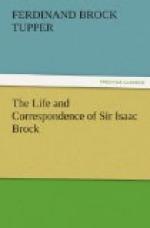FOOTNOTES:
[Footnote 61: The captain of the spies was killed and scalped on the march. “Thus fell the brave, generous, and patriotic McCulloch, captain of the spies,”—and in a foot note a few pages before—“Captain McCulloch, of the spies, scalped an Indian, whom he killed in the engagement,” in Upper Canada! We quote from Brown’s-American History, so it appears that at least one patriotic American could scalp as well as the Indians!]
[Footnote 62: Christie’s Memoirs.]
[Footnote 63: Christie’s Memoirs.]
[Footnote 64: The American historian, Brown, observes: “In the meanwhile, Michilimakinack surrendered to the British without resistance. The indefatigable Brock, with a reinforcement of 400 regulars, arrived at Maiden; and several Indian tribes, before hesitating in the choice of sides, began to take their ground and array themselves under the British standard.” Vol. i, page 64.—100 regulars!]
[Footnote 65: Now Colonel Glegg, of Thursteston Hall, Cheshire.]
[Footnote 66: His age was then about forty.]
[Footnote 67: The American historian, Thomson, in his “Sketches of the War,” says that General Hull surrendered “to a body of troops inferior in quality as well as number!” and he adds: “When General Brock said that the force at his disposal authorized him to require the surrender, he must have had a very exalted opinion of the prowess of his own soldiers, or a very mistaken one of those who were commanded by the American general.”]
[Footnote 68: Including four brass field pieces, captured with General Burgoyne, at Saratoga, in 1777, and which were retaken by the Americans, at the battle of the Thames, in October, 1813.]
[Footnote 69: Afterwards named the Detroit.]
[Footnote 70: Appendix A, Section 2, No. 1. Jefferson’s Correspondence.]
[Footnote 71: Christie’s Memoirs.]
[Footnote 72: Doubtless an error for 1330, the entire British force.]
[Footnote 73: There is a tradition in the editor’s family, that one of its members removed from Guernsey to England early in the seventeenth century, and that a son of his, a clergyman, settled in the island of Barbadoes, whence he or his family emigrated to the then British provinces of North America, now the United States.]




